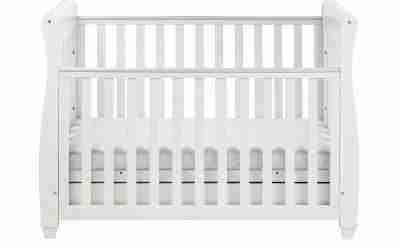
Many cots come with a mechanism on one side that enables it to fold or slide down, hence the name “drop side cot”
Most cot beds have side rails that are around 84-90cm high in the highest position, which makes them challenging for shorter people to reach over to lay a sleeping baby down. A cot bed with a drop side will reduce this height, making it easier to reach your baby.*
Bending over is particularly common cause of back pain. With a fixed side cot, you have to bend over the side to lift your baby in and out. When your baby is old enough to sit up unaided, the base of cot will be set to the lowest position and you would then have to bend even further over to pick up much heavier child! Then consider the fact you’ll have to do this several times a day.
With drop side cots, the side slide down about 15cm, preventing you from bending your back further into the cot while lifting the child as well as stopping any awkward stretching to reach and lift your child.
We highly recommend these types of cot. If you have previously injured your back, even if it was some time ago, it is likely muscles and ligaments in your back may still be sensitive, so a drop side is the perfect solution.
For the causes of back pain, back injury and how to prevent it, check our NHS guidelines
www.nhs.uk/Conditions/Back-pain/Pages/Introduction.aspx
http://www.which.co.uk/reviews/cot-beds/article/how-to-buy-the-best-cot-bed
The US safety commission (CPSC) banned drop sides in 2011, with a new safety standard aiming for tougher testing on the stability and durability of cots. The incidents reported in the US were mostly caused by malfunctioning of cheap plastic mechanisms, in some cases parents ignored malfunction of the mechanism and continued the use of cot, result in the drop side rail partially detaching from the cot and creating a dangerous V shape gap between mattress and the drop side rail, where a young infant could get caught and trapped.
The US safety standards of cots were and still are very much different than British and European ones. Before the 2011 US ban, unlike British safety standards of cots, US standards did not require the mechanism of drop side be auto locked while the rail was in the top position, and did not require the drop side mechanism to unlock with only two consecutive actions before the side could be moved. The testing of the drop side mechanism was also not as detailed and rigorous as the British and European standards.
Therefore, the differences in UK drop side mechanism means that it would not be possible for incidents like those in the US to happen on a British cot bed
Since the US ban of drop side, British and European safety standard of cot EN716 was revised in 2011 and 2013. Additional requirements were added to the standard along with more rigorous testing to drop side cot. i.e. the mechanism now must auto lock in both top or bottom positions, with two consecutive actions to unlock and lower/rise the rail.
British drop sides have been around for decades with a long history of safety records so parents continue support them for their obvious benefits.
Assembly correctly with the proper checks, it is safe sleeping space for your baby.
For further reference, check drop side cot topic on mumsnet.com; which.co.uk and goodtoknow.co.uk
Babymore’s unique ‘Lift and Nudge’ drop side mechanism is one of few that passed the rigorous test of the latest British safety standard. The mechanism is integrated into the side rail, with specially designed metal pins connected to the cot ends. Together, the mechanism not only auto lock in both up and down position, and it require two consecutive actions to unlock, eliminated possibility of the side rail to sudden drop or partial detach from the cot.
Our range of cot beds and their mechanisms are tested and approved for use by Intertek (UK Company -The largest tester of consumer goods in the world), against the latest British safety standards of Children’s cots for domestic use – BS EN 716-1/2:2008+A1:2013.
Each year, thousands of Babymore drop side cot beds are distributed to British parents. We are confident that you will find the drop side cot to offer your baby the very best in comfort and quality.
Read the instructions for safe use that come with your cot.
Make sure you follow the assembly instructions step by step.
To prevent assembly errors, we’ve produced an assembly video for most of our drop side cot beds available on Babymore website and YouTube.
If you could not find a video for your specific cot bed, check the video below. Although it’s a different cot bed, it has the same drop side mechanism across a range of our drop side cots.
1min 10 sec into the video, it shows the correct assembly of a drop side rail, and follows with how to operate the drop side.
Review the assembly if drop side does not operate smoothly.
Our tips:
Read more: http://www.which.co.uk/reviews/cot-beds/article/how-to-buy-the-best-cot-bed








